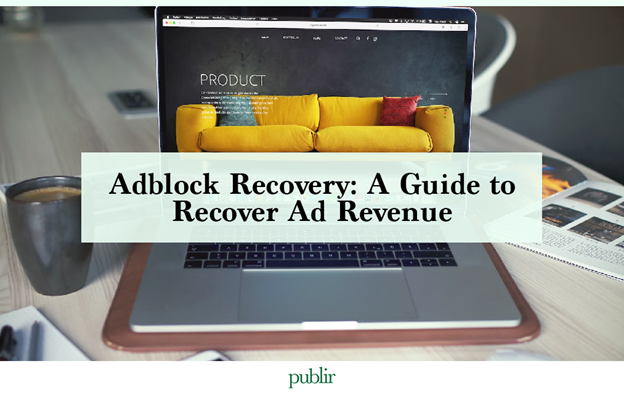
The use of Adblockers has been on the rise since 2013, when they were first invented. According to a survey, around 40% of US internet users utilize an Adblocker to improve their browsing experience. The Adblocking trend is accelerating at a greater pace for mobile devices than the desktop. Adblocking has caused significant revenue losses for online publishers, amounting to the revenue impact of tens of millions. As such, publishers are keen to find solutions to mitigate the impact of AdBlockers and recover the lost ad revenue. In this short piece, we will discuss how publishers can capitalize on Adblocker solutions and increase revenues.
Understanding AdBlock
Adblock is a software solution that improves user experience by preventing advertisements from displaying on the users’ web pages. Adblockers can come in the form of browser extensions and stand-alone applications or may be built into the browser. Generally, when a web page is opened, ad exchanges and networks communicate with the ad server using ad tags to display the ad. However, Adblockers detect the ad tags and prevent them from calling the ad server that loads the advertisement.
The boundary between ad blockers and content blockers is becoming increasingly blurred. As some Adblockers work on various filters that can be configured to a variety of content (besides ads), the broader term content blocker is often deployed. The most common Adblockers in the US include Adblock (50%), Adblock Plus (25%), AdGuard (19%), and uBlock Origin (16%). Adblockers work on most types of advertisement formats.
How Many People Use Adblock Around the World?
AdBlockers have become increasingly popular in the US and worldwide. Last year, there were 586 million AdBlock users enabled on mobile and 257 million Adblock users. A GlobalWebIndex survey revealed that 48% of Adblock users felt that there were too many ads online, 33% of them felt that ads lowered their loading speeds, and 47% said that the ads were irrelevant and annoying. Other users believed that ads compromised their online privacy and security, intruded into their online browsing experience, used a lot of battery life and data, and took substantial screen space.
How do Adblockers Work?

AdBlocker software is usually made of two pieces of code: filter lists and blockers. A filter list is a group of rules that define which elements have to be blocked. Like Adblockers, there are different kinds of filter lists, including those built-into browsers and stand-alone applications. Blockers are designed to block content that is configured in the filter list or Adblocker user settings. When the web page is loaded, the Adblocker compares the filter lists (including the specific elements the user has opted to block) it was supposed to block and the page code. Based on specific blocking rules, the blocker obstructs the ads from appearing on the user’s screen.
Every Adblocking solution is different and unique, but most work by stopping calls to the ad-related servers that load the advertisement on the user’s webpage. When a webpage is being loaded, the Adblocker reads the elements of the page, identifies any calls to ad-related servers and sources, and then compares them with elements in the filter lists to block. In case of a match, those elements are blocked from being displayed on the user’s webpage. Adblockers can be configured to block specific elements from displaying on the page.
Adblock Recovery Explained

Adblock recovery refers to the variety of solutions that publishers use to recover the revenue losses due to Adblock use. Adblock recovery solutions detect if the user is utilizing an Adblock solution, and they apply different methods to measure and report the revenue loss, whitelist the website, block access to the Adblocker based on site use terms and conditions, reinsert the ad, offer an alternative value exchange between the visitor and content publisher. Most publishers use a combination of these techniques to curate an effective Adblock recovery solution.
Tools and Technology for Adblock Recovery
Some Adblocking solutions include:
- Adblock Detection and Analytics – Adblock recovery solutions begin by detecting the presence of Adblockers on the user’s webpage. Publishers need to review their recovery solutions as Adblockers constantly make improvements to undermine recovery measures. Additionally, there are solutions that measure the impact of Adblockers on your website revenue. This gives you an estimate of the money you are losing.
- Website Whitelisting – Website allow listing or whitelisting refers to the process in which users allow certain websites to be exempt from their Adblocking functions. Without disabling their Adblockers, users can choose the websites they want to allow. Often users allow or whitelist websites with more sensible or responsible content with limited ads.
- Ad Reinsertion and Replacement – Ad reinsertion is a technique in which the original advertisement is reinserted by bypassing the Adblocker, leveraging certain loopholes. This method is often criticized for not taking into account the user’s consent. On the other hand, ad replacement identifies the blocked ad and replaces it with an alternative ad. The ad is replaced with the consent of the user who has allowed “Standard Ads” to be displayed on their screen.
- Alternative Value Exchange – This means the variety of offers the publisher can make to the Adblocker to allow their content on the webpage. For instance, the publisher can offer the readers access to their paid recurring subscriptions in exchange for allowing their content.
The above discussion underpins the need for Adblocking solutions in the ever-changing market. As Adblockers have evolved with time, so have Adblock recovery solutions. None of the Adblock recovery solutions discussed above are mutually exclusive. As noted earlier, the most successful publishers use a combination of these to get the most effective return.
At Publir, we’re experts in the content monetization space, offering a one-of-a-kind unified platform for a diversified strategy. Our offerings focus on Ad Optimization, Adblock Recovery, Subscriptions, Fundraising, and Merchandising.
